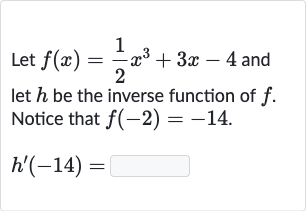Full solution
Q. Let and let be the inverse function of . Notice that .
- Find : To find , we need to use the formula for the derivative of the inverse function: where .
- Find : Since , we have when . Now we need to find .
- Differentiate : Differentiate to get .
- Plug : Now plug into to find : .
- Use formula for : Use the formula for the derivative of the inverse function: .
More problems from Transformations of quadratic functions
QuestionGet tutor help

